Beam Reach and the Gato Verde had an excellent opportunity this term during the Beam Reach program. A film crew and a producer of the Show “Orca: The Sea Wolf†came aboard the Gato Verde to do some filming of the program and mainly Orcas and communication. Alexis, a producer from Pangolin Pictures, came aboard on May 27, 2009 around nine at night. She gave us release forms to sign and then she went to bed after a long day. Then in the morning Jeff, the cameraman, and his wife Kim came aboard. They started to film us releasing the boat, heading out, and our normal routine with getting updates on the whales. I got to make a phone call to Mark Mallison, a contact in Victoria, and have the entire conversation filmed. Then once we were out, Erica and Matt did some hydrophone deployment, got many shots of the Gato Verde, and us searching for the whales. It was a pretty cool day, and we all can’t wait until we get updates on the show and when it is going to air! We are going to be in a small portion on the Discovery Channel! That is so cool and we are super excited! It was a great experience to have because we got experience the world of entertainment of a bit and got a peak into what our futures are going to be like we ever get filmed again. Plus it was excellent advertisement for Scott, Beam Reach, and the Gato Verde! That is always a good thing! A new learning experience was gained with this experience and along with the many more from this program.
Read More
       Surfactants are used in our everyday life, whether we are washing our hands to our hair, cleaning dishes, or cleaning clothes. Surfactants play an important role in our everyday life as humans. Surfactants work by having a hydrophilic head, which loves water and a hydrophobic tail, which hates water. What makes it so useful is the fact that the hydrophobic tail will leech onto all the oil and grease we on household items and on ourselves. Then when each of the tails form a core that encloses an oil droplet, this is called a micelle. This makes both of each end of a surfactant happy. What is useful to humans is causing harm to fish and other inner tidal organism.
           Erica and I, as Beam Reach students in the spring 2009 term, have decided to measure the surfactants that the program releases into the ocean, while on the Gato Verde. With the help of Dr. Russel Barsh we have created a process of measuring each of the samples we have collected on the Gato Verde.
           This is our process for collecting each sample:
1.    Must be 48 hours before we run the test, if it sits to long the sample turns bad.
2.    Rinse syringe three times in sample test water
3.    Attach the filter to the syringe
4.    Filter out the sample and place into a clean container
5.    Place in the refrigerator to keep cool
Once we get back to the Friday Harbor Labs and meet Russel, here is the sample
testing process:
1.    Dilute the sample: 1mL of sample to 99mL of nano pure water.
2.    Scan the blank sample
3.    Add bicarbonate of soda to bring the pH up (used as a buffer)
4.    Add sodium chloride (salt) to bring up the density of the water.
5.    Add 2mL of methylene blue and toluene mix
6.    Mix for 1 minute to allow the formation of micelles
7.    Let it sit for 5 minutes
8.    Shoot the sample
9.    Read the Results
Our results with the four samples we have taken are:
1.    1st grey water sample: 1.7 ppm (2 gallons of water with 2 squirts of joy soap)
2.    2nd grey water sample: 5.5 ppm (4.5 gallons of water with 2.5 squirts joy soap)
3.    Roche Harbor: 0.3 ppm
4.    Mitchell Bay: 1.5 ppm
Most of these numbers are terrible, because 0.5 ppm is lethal to fish and inner
tidal organisms. Some of the effects are disrupting gas exchange across the gill, which clogs up oxygen exchange, and it suffocates the fish. It can also clog pours and disrupt membranes in crustacean causing the membrane to burst. If surfactants are doing damage to fish, how can that affect the SRKW? Our best option right now is to use less, but still find a efficient way to be clean! Remember the saying less is more.
Â
Best Wishes,
PeterÂ
Â
PS: Thank You Dr. Russel Barsh for helping us in the lab and informing us about surfactants and its effects!  Â
Â
Â
Â
Â
Â
Â
Â
Read More
Sucia to Stuart
5/12/09
We first started off the day excited to see whales. We kept in contact with Ivan, Jim, and Mark in order to work as a team to find the whales. The whales were spoted on the south end of the San Juan Islands and heading towards south of Discovery island. The big problem was we were way up north and it was going to take us three hours to get to the middle of Haro Strait. DUring our long journey we played with the fish cam, sailed, and Scott gave us a lecture on Temperature and Salinity Oceanography. Then it was a battle with the waves! As we went further south, the waves got higher as we began to feel sick. WE all kept it together in the name of science! Once we were down south, we got a message on the radio by Jim that the SRKW were being heard on Orca sound! It was time to head north and find the whales! We saw lots of boat action as we got closer to Stuart, and saw lots of the vapors from their blow holes! WE kept tracking them, but failed because they were head up to the Swanson Channel, in Canadian territory! We failed and had to turn around and try tommorrow. We were defeated today, but there is always tommorow! The Beam Pod is ready for another day of SCIENCE!
Read More
On Thrusday May 7, 2009 I helped out Cindy Hansen, the education curator, at the Whale Museum.  She had a group of 2nd and 3rd grade students come for a killer whale and gray whale workshop!  During the Killer Whale presentation she talked about the biology of a whale, the different types of whales, acoustics, and a id exercise.  I got to talk about my project, the purpose of Beam Reach, and my encounters out at sea.
It was amazing to realize how much these kids know!  They are extremely smart!  I was explaining the behaviors of the transient killer whales the couple of times we saw them the first week.  Then one of the kids raised his hand and said “You don’t need to explain what spy hopping and breaching is, we already know what it is.”  I was like okay, that is really cool!  Then the kids did an exercise trying to identify the Southern Resident killer whales (SRKW)!  It was amazing to see how observant and fast these kids pick up on things.  I was really impressed!  They seem to be very interested in the subject, as well as, my project. Â
Once the discussion was over they did another exercise were they each got a blue card and a sheet with the different SRKWs. Â On the cards, they had to write which whale they got and why their whale is special. It was so cute! Â I enjoyed what each kid had to say. Then they had to split up into pods and find out who their family was. Â It was a great thing to see. Â Along the way, many of the kids and parents asked me many different questions. Â It seemed like the parents asked more weird questions than the kids, I thought it was funny!Â
After that they went upstairs and had a tour of the museum. Â The hit with this group of kids was the read phone booth where you can call whales and listen to their different calls. Â Once they got to the hydrophone area, i got to speak all about hydrophones, like what they do, how we use them, and where they are located. Â I was once again amazed on how much they know and remember. Â These kids even know the whale wise rules! Â They were great! Â While the kids were looking around at the exhibits and taking pictures a lot of the parents came up to me and asked me about college and my studies here at Beam Reach.
Once they were done with the tours, they took a lunch break. After lunch they had a presentation on Gray Whales. Then it was time to put Stinky Bill together.  The kids loved the fact that they were real whale bones.  The kids got split up into four groups and I was in charge of helping the kids find the matching ribs.  My secret to knowing that they were matching was it was labeled! I found it funny that the parents call me the expert.  Then the kids caught on to what i was doing and did the same.  They built this whale with lots of team work.  Why can’t the world work like these kids, with lots of team work? Remember we are all in this together! Â
After they were done they talked about how the gray whale could have died and took votes on it. Â My favorite one was the killer whales rammed the gray whale until its ribs were broken. I was thinking, that kid is totally cool! That is what i wanted the answer to be, but it was hit by a boat. Â
After the program was done the kids did some smart shopping at the gift shop and i helped Cindy pack up Stinky Bill, put away chairs, and clean the floors. I had such a great time and i wish i could do it again!
Read More
Â
We just got back from our first two weeks out at sea on the Gato Verde!  Besides seeing all the marine mammals, sailing is one of my favorite parts!  I have enjoyed the times on the Gato Verde, with the exception of a few times of sea sickness.  I like the adrenaline rush of putting up the main sail.  Then working together to do a proper and efficient tack!  Learning how to sail with Todd is a great experience and i hope to continue it after my adventure with Beam Reach. Â
One of my favorite parts of sailing is at the Helm!  I like the feeling of cruising alone on a nice day out at sea.  I feel so calm and relaxed.  I feel like i am in a different world, then i get a rush of excitement when i have to say “Ready to Tack?” and shift the boat in the proper direction.  Then you can go back to cruising along!  When i am at the Helm i do find it way easier to find a land mark and just follow and every once in a while looking at the instruments to make sure we are safe.  If i have my head wrapped around the instruments to much i just get confused.  So my advice to any future Beamers, just go with the flow and pick a land mark that works for both you and Todd!
Another good part of sailing is the fact that it is fun!  The more you sail, the easier the terminology gets.  You get use to using the terms like Starboard, Port, Bow, Stern, Leech, Luff, Main, Traveler, etc.  Sailing is just one of things that takes practice and a smile! Â
What else i like about sailing is it is a team effort! I strongly believe in working together and in my opinion you need teamwork to sail nice and smooth.  Then once you have lots of experience you can sail by yourself and enjoy the seas through your own eyes.  That is how dreams grow and then come to life right in front of you!Â
Plus another great bonus of sailing, is all the great marine animals you get to see along the way!
Best Wishes,
Peter
PS: Have some fun and safe sailing!
Read More
Garrison Bay – Roche Harbor – Reid Harbor
We first started off our day heading towards Roche Harbor to do a captain switch and pick up Val. Before we went into Roche Harbor we did a range (distance estimate) exercise. We had to guess how far an object was then Jason told us the real answer. Then we got to play with the radar and see the difference. Then I got to radio the Harbor Master to find out where we were going to dock while we waited for the rest of the crew!! While we were there the meat eaters got their fix. Once Todd showed up with the supplies we refueled the Gato Verde and headed out to Reid Harbor. Before we went to Reid we floated around Haro Straight hoping to see the Southern Residents. We deployed the listening hydrophone at a latitude of
48 degrees and 38.7 North and a longitude of 123 degrees and 12.72 West. We did see plenty of Harbor porpoies, but we heard no whales. So then we turned everything off and had journal club discussion which I lead. The title of the paper was “Underwater noise of whale-watching boats and potential effects on killer whales (Orcinus Orca), based on an acoustic impact model” by Christine Erber. During journal club we reached Reid Harbor and Matt and I started to cook. We did not see any whales today, but I am sure we will see them as the season goes on.
Read More
April 11, 2009
On this beautiful day, the Beam Pod was taught how to sail in dinghy’s!  One of the dinghy’s was owned by Mr. Val Veirs and it was a nice and new one.  Then the other one was owned by Mr. Jason Wood and his was older and had a classic look.  The afternoon first started off with Val explaining each part of the dinghy, there is the center board, the rudder, the jib, and the sail.  The center board keeps the boat balanced and makes it harder for the dinghy to tip over.  The rudder is at the edge of the boat and it steers the boat in the direction you want it to.  Then the jib hold the sail in front of the dinghy and the sail is self explanatory.  It was very interesting getting into each boat and trying not to fall in before our plunge this week.  I went into Val’s dinghy first and i almost fell in because i was not in the center.  Then Matt got in just fine and then trying to sail the dinghy to the next dock was very difficult.  None of the parts were in the dinghy and i found out that i suck at paddling.  So once matt got us to the dock, Val showed us how to put the sail together and how to sail.  I was first in charge of the rudder and the two terms were tac and jibe.  Tac means to turn into the wind and jibe is to turn away from the wind.  Val said when we are ready to tac scream “Ready to tac” so the rest of the crew can duck!  Then we returned to the dock and Matt came in with Hilary and I.  We all had a great time sailing in Val’s dinghy and i do have to say that Matt is a crazy driver enjoying all the fast turns!
Then things started to change once Hilary and I went into Jason’s dinghy.  First of all, when i entered it almost tipped over and i let some water in!  Once we were situated everything went bad because Jason’s rudder is more sensitive the Val’s and you need to turn it very slightly.  When i was steering Jason’s dinghy it was going all over the place.  We had to stop and paddle because we were going to run into the rocks, but once we got it going it was pretty cool.  After i awhile i got nervous and was scared that we were going to break it, so i got out.  Then Hilary went out by herself and Jason’s dinghy seems more of a one person then a two.  It was a good experience and i hope to ride in Val’s dinghy again and not Jason’s lol.  Sorry Jason but yours is to scary for me, but i had fun!
Sailing is so much fun and i cannot wait until the Beam Squad goes on the Gato Verde! Â
We Are All in This Together,
Peter
Read More

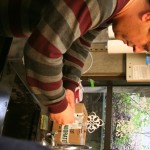
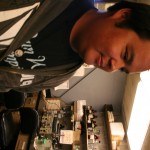
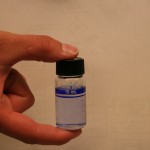
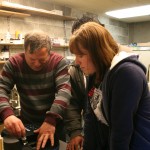
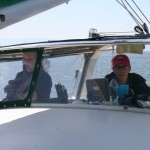
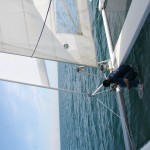
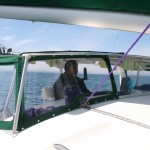
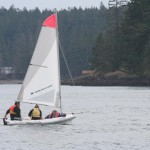
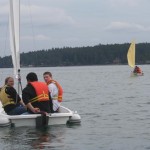
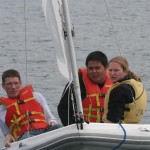


 Twitter
Twitter LinkedIn
LinkedIn Facebook
Facebook